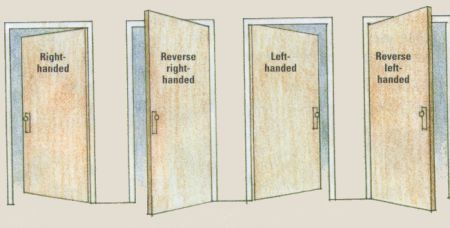 If you aren’t in the door and lock industry, you may not know what door handing means. In fact, I’ve heard countless people say, “Wait. Door handling?” Nope. Not a typo. It’s door handing. If you had asked me what it meant before I started working for LockNet my response would have been something like, “Uh… the way you put a knob on a door?” followed by a super confused look. That answer isn’t even close.
If you aren’t in the door and lock industry, you may not know what door handing means. In fact, I’ve heard countless people say, “Wait. Door handling?” Nope. Not a typo. It’s door handing. If you had asked me what it meant before I started working for LockNet my response would have been something like, “Uh… the way you put a knob on a door?” followed by a super confused look. That answer isn’t even close.
Door handing refers to the direction in which the door swings, and there are two reasons why it’s important. First, you have to know how a door is handed (or is going to be handed) so that the appropriate hardware can be ordered. If you order a right hand door but a left hand lever set, the two aren’t going to be compatible and you’re going to be stuck with a door that doesn’t open. Second, you want to ensure the door you’re installing swings in the correct direction.
Before production even begins, it’s important to specify what type of door handing you need for your facility. Once you’ve done that, the door and all of the hardware and/or door preps will arrive on-site. If you choose to order your locking hardware separately, you need to be mindful of the various part numbers for each handing option so you’re ordering the correct ones. It’s important to note, however, that some hardware handing can be adapted during installation.
How Can A Door Handing Be Done?
It turns out, there’s more than one way to skin a cat and hand a door. Here are your options:
- Left Hand
- Left Hand Reverse
- Right Hand
- Right Hand Reverse
So, how exactly do you determine which one to use? There are actually a couple of tricks you can use to do it yourself. First, while standing in the doorway with your back against the hinge, point your arm in the direction the door swings. If the door swings out of the area you plan on securing, pay attention to the arm you’re pointing with. That will determine whether your door will be left or right handed reverse. If you’re pointing with your right arm, the door will be left handed reverse. If you’re pointing with your left arm, the door will be right handed reverse.
If the door swings into the area you want to secure, the door will be right or left handed depending on the arm you’re pointing with, as well. If you’re pointing with your left arm, then the door will be left handed, and so on. (Still with me?)
The second trick you can use to help you with the handing of your door is to simply look at the hinges. If the hinges are on the right side, and the door swings in to the room in which you’re entering, that would be a right hand active door. If the door swings outward, toward you, and the hinges are on the right side, that would be a right hand reverse. It’s a little easier if you check out the newsletter below:
So, there you have it! Door handing is pretty simple as long as you know your left from your right! But, if you have any questions or concerns, I happen to know a few people who would be able to help. Just give us a call here at LockNet!
